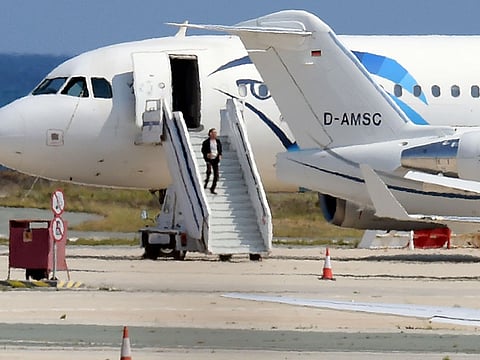EgyptAir hijack saga ends peacefully
Hijacker arrested and hostages freed in Cyprus

Cairo: Fifty-five passengers of an EgyptAir plane were on Tuesday released peacefully in Cyprus after they were briefly held hostage by a lone hijacker.
Flight 181 from Alexandria to Cairo was hijacked shortly after take-off early on Tuesday by an Egyptian national who said he had explosives and demanded the Airbus A320 aircraft land in Cyprus or Turkey.
Pilot Amr Al Jamal reportedly told the hijacker the plane fuel was adequate only to fly to Cyprus where the airliner landed at the Larnaca airport. There were eight crew members aboard the plane, according to Egyptian authorities.
The hijacker, identified as Saif Al Deen Mustafa, released passengers gradually through negotiations with Cypriot authorities. He was later arrested. Mustafa, 58, has reportedly asked for political asylum in Cyprus.
EgyptAir, citing information from Larnaca, said the hijacker’s explosive vest was found to be fake.
The incident prompted Egyptian authorities to set up an operations room, led by Prime Minister Sharif Esmail, amid fears in Cairo that the fallout from the incident could hurt Egypt’s efforts to revive its ailing tourism.
Addressing a press conference in Cairo earlier on Tuesday, newly appointed Minister of Civil Aviation Sharif Fathi said the government was treating the plane hijacking as a “real threat”.
“We are dealing with it as a real threat,” he said.
No terror link
The hijacking is not believed to be terror related with news agencies reporting the hijacker demanded to speak with his ex-wife after the aircraft landed at Larnaca airport at 7.50am. Fathi said the Egyptian government was not aware of the hijacker’s demands or whether the explosive device was real.
He said the situation was being handled at the “highest level”.
He declined to reveal nationalities of the passengers, suggesting it could hurt the negotiations.
“I won’t give information unless it is verified.”
However, aviation sources said that the passengers were 30 Egyptians and 25 foreigners, including Americans, Britons, Belgians, Dutch nationals, a Frenchman, an Italian and a Syrian.
The other hostages were the aircraft’s two pilots, a stewardess and an airline security official.
The hijacker had let passengers off the aircraft since it landed in Cyprus. At one stage, he held five passengers and seven crew members hostage, according to EgyptAir. Shortly later, the number of hostages dropped to three foreign passengers as well as the pilot, co-pilot and two cabin crew members.
Earlier reports identified the hijacker as Ebrahim Samaha, an Egyptian veterinary professor holding a US passport. However, his wife and colleagues said he was one of the passengers who had been taken hostage and later released.
Larnaca airport was closed to flights after the hijacking.
Airport security
Emirates and Qatar Airways diverted flights scheduled to land in Cyprus. The Emirates flight was diverted to Athens in Greece and the Qatar Airways flight was diverted to Amman in Jordan, according to spokespersons from the airlines.
Egypt thanked Cyprus for what it described as its “close cooperation” in ending the hijacking incident.
“The Cypriot authorities have shown over the past hours a distinguished swift response, high professionalism and appreciated wisdom in handling tough security challenges like today’s hijacking,” a presidential statement said.
Egyptian President Abdul Fattah Al Sissi had called his Cypriot counterpart Nicos Anastasiades to discuss the crisis, state media reported without further details.
Passengers of the hijacked flight were expected to be brought back to Egypt aboard a special plane during the day, aviation authorities said.
The hijacking has once again raised questions about security at Egyptian airports.
Fathy said the Egyptian government does not know how the hijacker got through security checks at Alexandria’s Burj Al Arab airport with what is claimed to be an explosive vest.
In October 2015, a Russian passenger jet crashed in the Egyptian Sinai shortly after take-off from Sharm Al Shaikh, killing all 224 on board.
A Daesh affiliate claimed responsibility for bringing down the aircraft. Russian and Western countries have said they believed the flight was brought down by a bomb smuggled on board the aircraft.
Sign up for the Daily Briefing
Get the latest news and updates straight to your inbox


